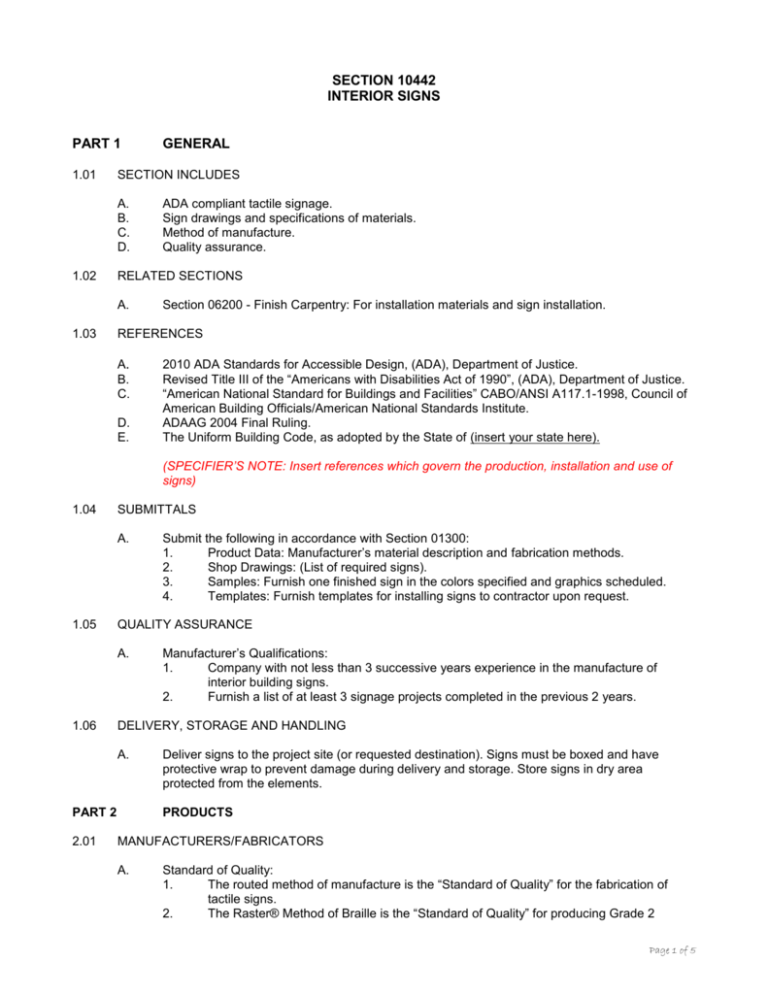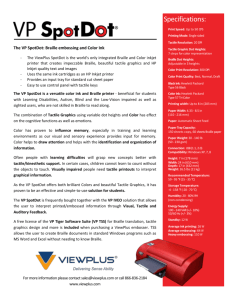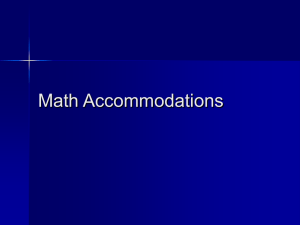General Interior Signage ADA Spec Document 2012
advertisement

SECTION 10442 INTERIOR SIGNS PART 1 1.01 SECTION INCLUDES A. B. C. D. 1.02 ADA compliant tactile signage. Sign drawings and specifications of materials. Method of manufacture. Quality assurance. RELATED SECTIONS A. 1.03 GENERAL Section 06200 - Finish Carpentry: For installation materials and sign installation. REFERENCES A. B. C. D. E. 2010 ADA Standards for Accessible Design, (ADA), Department of Justice. Revised Title III of the “Americans with Disabilities Act of 1990”, (ADA), Department of Justice. “American National Standard for Buildings and Facilities” CABO/ANSI A117.1-1998, Council of American Building Officials/American National Standards Institute. ADAAG 2004 Final Ruling. The Uniform Building Code, as adopted by the State of (insert your state here). (SPECIFIER’S NOTE: Insert references which govern the production, installation and use of signs) 1.04 SUBMITTALS A. 1.05 QUALITY ASSURANCE A. 1.06 Manufacturer’s Qualifications: 1. Company with not less than 3 successive years experience in the manufacture of interior building signs. 2. Furnish a list of at least 3 signage projects completed in the previous 2 years. DELIVERY, STORAGE AND HANDLING A. PART 2 2.01 Submit the following in accordance with Section 01300: 1. Product Data: Manufacturer’s material description and fabrication methods. 2. Shop Drawings: (List of required signs). 3. Samples: Furnish one finished sign in the colors specified and graphics scheduled. 4. Templates: Furnish templates for installing signs to contractor upon request. Deliver signs to the project site (or requested destination). Signs must be boxed and have protective wrap to prevent damage during delivery and storage. Store signs in dry area protected from the elements. PRODUCTS MANUFACTURERS/FABRICATORS A. Standard of Quality: 1. The routed method of manufacture is the “Standard of Quality” for the fabrication of tactile signs. 2. The Raster® Method of Braille is the “Standard of Quality” for producing Grade 2 Page 1 of 5 3. B. C. 2.02 Braille. Manufacturers licensed to use the Raster® Method of Braille do not need to submit for substitution approval prior to bid, but must furnish with their bid a letter certifying that they are a licensed Raster® user or are providing products manufactured by a licensed Raster® user. Digital Imaging using fade-resistant interior/exterior UV inks and printing directly onto substrate materials with 2400 x 1200 dpi resolution and a 14 micron spot size is the “Standard of Quality” for graphic image or photo reproduction. Acceptable Manufacturers: Subject to compliance with requirements, acceptable manufacturers of products are: 1. (your company name here) 2. 3. All other manufacturers/fabricators seeking approval of their products must comply with requirements of the Instructions to Bidders (AIA Document A701, Paragraph 3.3), prior to bidding. No substitutions of materials or method of manufacture allowed without prior approval from sign consultant and client. SIGN SYSTEM Refer to project sign schedule for specific information on sign materials, shapes, sizes, color and other design information. (List manufacturers and sign component from manufacturers’ literature.) A. Frame Design: (choose from the following) 1. Styrene Modular Frame System: Injection molded high-impact styrene frames with holes to accommodate snaplocks attached with adhesive to insert panels. a) Square edge b) Round edge c) Half-Round frames 2. Aluminum Modular Frame System: Extruded aluminum frames featuring grooves to accommodate snaplocks attached with adhesive to insert panels. a) 100 Series Edge Design: thin edge with sign insert recessed into the frame. b) 200 Series Edge Design: 1/16 inch (4.8 mm) radius edge with sign insert recessed into the frame. 3. (other) (SPECIFIER’S NOTE: Select sign insert type below) B. Sign Insert Materials & Engraving Substrates: (choose all that apply) 1. Modified acrylic 1-ply engraving substrate with non-glare finish 2. Modified acrylic 2-ply engraving substrate with non-glare finish 3. Non-glare Acrylic 4. 1-ply Aluminum sheet with satin anodized finish 5. Chemetal® 6. Belbien 7. (other) C. Production Methods: (choose all that apply) 1. Routed method of engraving a) Applied material method (standard) b) Inlay material method (for high abuse or vandal prone areas) 2. Digital Imaging 3. Hot-Stamping 4. (other) D. Braille: Page 2 of 5 The Raster® method for fabricating Braille is the required standard of manufacture. (Choose Raster® colors and materials from manufacturer’s literature.) E. 2.03 Sign Removal Tool: (if applicable) 1. Clear flexible vinyl suction cup. 2. (other) MATERIALS/COMPONENTS/DESIGN A. Frame Shapes and Sizes: Refer to project sign schedule for specific information on frame material, shape, size, color, and style. B. Sign Inserts 1. Approved Materials: a. PROFILE MATERIAL (to create tactile copy/graphics.): Matte finish with a minimum height of 1/16 inch (1.6 mm) and of a contrasting color from background material. (reference project sign schedule for specific material requirements) b. SUBSTRATES (sign background material): Matte or non-glare finish and of a contrasting color from the profile material. (reference project sign schedule for specific material requirements) 2. Finishes and Colors: Matte finish, ADA compliant for color contrast and surface finish. Refer to project sign schedules for specific information on colors. 3. Graphics: . a. Tactile Characters: Use approved profile material, computer engineered, adhesive-backed, raised graphics, complying with ADAAG 2010. b. Pictograms: All “symbols” must match as closely as possible the published “international” symbols. Other interpretations will not be deemed acceptable. All symbols must be approved prior to fabrication. (SPECIFIER’S NOTE: Surface graphics must meet ADA signage requirements for color contrast and surface finish. Select graphics colors from manufacturer’s actual color samples.) c. Braille: Use Raster® Method patented process for placing Braille dots on architectural signs; computer engineered, using special carbide engraving bit, press-fit tool with vacuum pump or automated insertion device (Auto-Raster®) or manual insertion device (Raster® Pen), and UV stable acrylic Raster® spheres. 1) Braille Message: All messages are required to be lower case, and may not directly reflect the style of the tactile letters. The indication of uppercase letter(s) should only be used for proper nouns and names, individual letters of the alphabet, initials, acronyms, or before the first word of sentences. 2) The Braille area shall be located below the corresponding tactile text. If the tactile message is multi-lined, the entire Braille text shall be located Page 3 of 5 below the tactile message with a minimum of 3/8 inch margin on all sides. d. 4. Digital Imaging: 1) UV-stable inks applied directly to material substrates. 2) High-resolution photo-quality image with resolution of 2400 x 1200 dpi. 3) Color Management tools applied for consistent color reproduction. Engraving Process: Tactile signage shall be profile engraved in accordance with the manufacturer’s instructions. (choose from the following methods of manufacture) a. APPLIED METHOD ( 2-piece construction): Apply approved profile material to the substrate material just prior to engraving, by removing the liner from the adhesive-backed profile material and placing on top of the substrate material. Engrave (cut) entirely through the profile material to produce raised letters, numbers and symbols. Peel (strip) the excess profile material immediately, leaving the raised letters, numbers and symbols characters bonded to the substrate. b. INLAY METHOD (3-piece construction): After two 1-ply 1/32 inch (0.8 mm) pieces of substrate (same color) have been bonded together and cut to size, cut inline text/graphics through top ply and weed immediately. Cut outline text/graphics from 1/16 inch (1.6 mm) profile material. Adhere text/graphics into recessed areas of substrate, 1/32 inch below material surface, using liquid adhesive. (NOTE: The Inlay Method specified above is recommended for high abuse or vandal prone areas. 2.04 5. Sign Insert/Snaplock Mechanism: Tamper resistant positive locking snaplock, adhesively applied to sign insert and designed to engage holes in frame and provide modular flexibility and ease of sign changeover. a. Sign inserts are easily removed by suction cup. Verify quantity to be furnished with each sign order. 6. Copy Window Signs: Manufacture by attaching front piece of 1/32 inch (0.8 mm) color engraving substrate material with adhesive to one piece of 1/32 inch (0.8 mm) clear engraving substrate material with no adhesive. Assemble inside frame for alignment purposes. Cut a rectangular window out of the front piece and weed out. Apply the profile material and engrave text/graphics. Then apply strips of 1/32 inch (0.8 mm) double-sided adhesive tape 1/8 inch (3 mm) away from the top and bottom of the window opening as well as at other areas on the sign deemed necessary to adhere the front piece to the color back piece. Paper insert nameplate should move smoothly when assembled. SOURCE QUALITY CONTROL A. All sign materials are to be new and free of defect. B. Manufacturers are responsible for providing accurate Grade 2 Braille that adheres to current ADAAG guidelines, as well as any guidelines adopted by individual states, and for providing Braille that accurately reflects the intent of the communication for the Braille reader. All signs shall be proofread for Braille accuracy. Any sign determined to be in error shall be replaced at no cost to the owner. Page 4 of 5 PART 3 3.01 EXECUTION EXAMINATION A. 3.02 3.03 Examine the substrates and conditions under which the work is to be performed, and notify the Contractor in writing of conditions detrimental to the proper and timely completion of the work. Do not proceed with the installation until unsatisfactory conditions have been corrected. INSTALLATION A. Mount room sign to wall surfaces with double-coated acrylic adhesive-backed foam tape, or with metal screws, or other appropriate hardware suitable to the substrate to which the frame will be mounted. Mounting height to comply with ADAAG 2010 guidelines as follows: 1. Tactile characters shall be 48 inches (1220 mm) minimum and 60 inches (1525 mm) maximum above the adjacent floor or ground surface, measured from the baseline of the characters. 2. Signs containing tactile characters shall have an 18 inch by 18 inch (455 mm x 455 mm) minimum space on the floor, centered on the sign, beyond the arc of any door swing between the closed position and 45 degree open position. B. Where permanent identification is provided for rooms and spaces, signs shall be installed on the wall adjacent to the latch side of the door. Where there is no wall space to the latch side of the door, signs shall be placed on the nearest adjacent wall. Mounting location for such signage shall be so that a person may approach within 3 inches (76 mm) of the signage without encountering protruding objects or standing within the swing of the door. SCHEDULE A. Provide the following interior signs: (see attached schedule). (SPECIFIER’S NOTE: Furnish complete list of required signs. Include text and symbols, if any. Indicate quantity of each. Manufacturer is not responsible for quantities not clearly indicated in this schedule.) END OF SECTION Page 5 of 5





